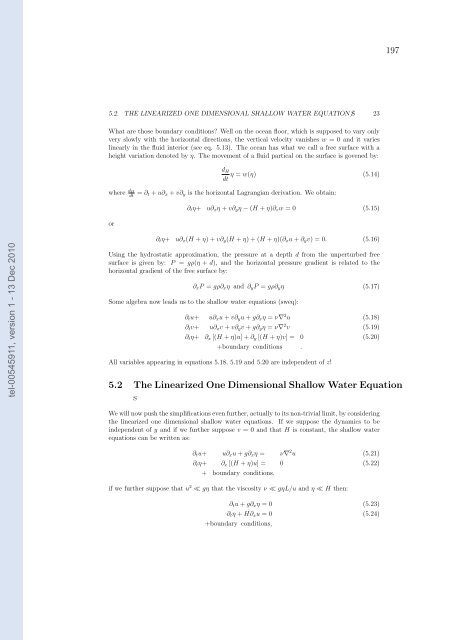Etudes et évaluation de processus océaniques par des hiérarchies ...
Etudes et évaluation de processus océaniques par des hiérarchies ...
Etudes et évaluation de processus océaniques par des hiérarchies ...
You also want an ePaper? Increase the reach of your titles
YUMPU automatically turns print PDFs into web optimized ePapers that Google loves.
197<br />
5.2. THE LINEARIZED ONE DIMENSIONAL SHALLOW WATER EQUATION̸ S 23<br />
What are those boundary conditions? Well on the ocean floor, which is supposed to vary only<br />
very slowly with the horizontal directions, the vertical velocity vanishes w = 0 and it varies<br />
linearly in the fluid interior (see eq. 5.13). The ocean has what we call a free surface with a<br />
height variation <strong>de</strong>noted by η. The movement of a fluid <strong>par</strong>tical on the surface is govened by:<br />
d H<br />
η = w(η) (5.14)<br />
dt<br />
where dH<br />
dt<br />
= ∂ t + u∂ x + v∂ y is the horizontal Lagrangian <strong>de</strong>rivation. We obtain:<br />
or<br />
∂ t η+ u∂ x η + v∂ y η − (H + η)∂ z w = 0 (5.15)<br />
tel-00545911, version 1 - 13 Dec 2010<br />
∂ t η+ u∂ x (H + η) + v∂ y (H + η) + (H + η)(∂ x u + ∂ y v) = 0. (5.16)<br />
Using the hydrostatic approximation, the pressure at a <strong>de</strong>pth d from the unperturbed free<br />
surface is given by: P = gρ(η + d), and the horizontal pressure gradient is related to the<br />
horizontal gradient of the free surface by:<br />
∂ x P = gρ∂ x η and ∂ y P = gρ∂ y η (5.17)<br />
Some algebra now leads us to the shallow water equations (sweq):<br />
∂ t u+ u∂ x u + v∂ y u + g∂ x η = ν∇ 2 u (5.18)<br />
∂ t v+ u∂ x v + v∂ y v + g∂ y η = ν∇ 2 v (5.19)<br />
∂ t η+ ∂ x [(H + η)u] + ∂ y [(H + η)v] = 0 (5.20)<br />
+boundary conditions .<br />
All variables appearing in equations 5.18, 5.19 and 5.20 are in<strong>de</strong>pen<strong>de</strong>nt of z!<br />
5.2 The Linearized One Dimensional Shallow Water Equation̸<br />
s<br />
We will now push the simplifications even further, actually to its non-trivial limit, by consi<strong>de</strong>ring<br />
the linearized one dimensional shallow water equations. If we suppose the dynamics to be<br />
in<strong>de</strong>pen<strong>de</strong>nt of y and if we further suppose v = 0 and that H is constant, the shallow water<br />
equations can be written as:<br />
∂ t u+ u∂ x u + g∂ x η = ν∇ 2 u (5.21)<br />
∂ t η+ ∂ x [(H + η)u] = 0 (5.22)<br />
+ boundary conditions.<br />
if we further suppose that u 2 ≪ gη that the viscosity ν ≪ gηL/u and η ≪ H then:<br />
∂ t u + g∂ x η = 0 (5.23)<br />
∂ t η + H∂ x u = 0 (5.24)<br />
+boundary conditions,
















